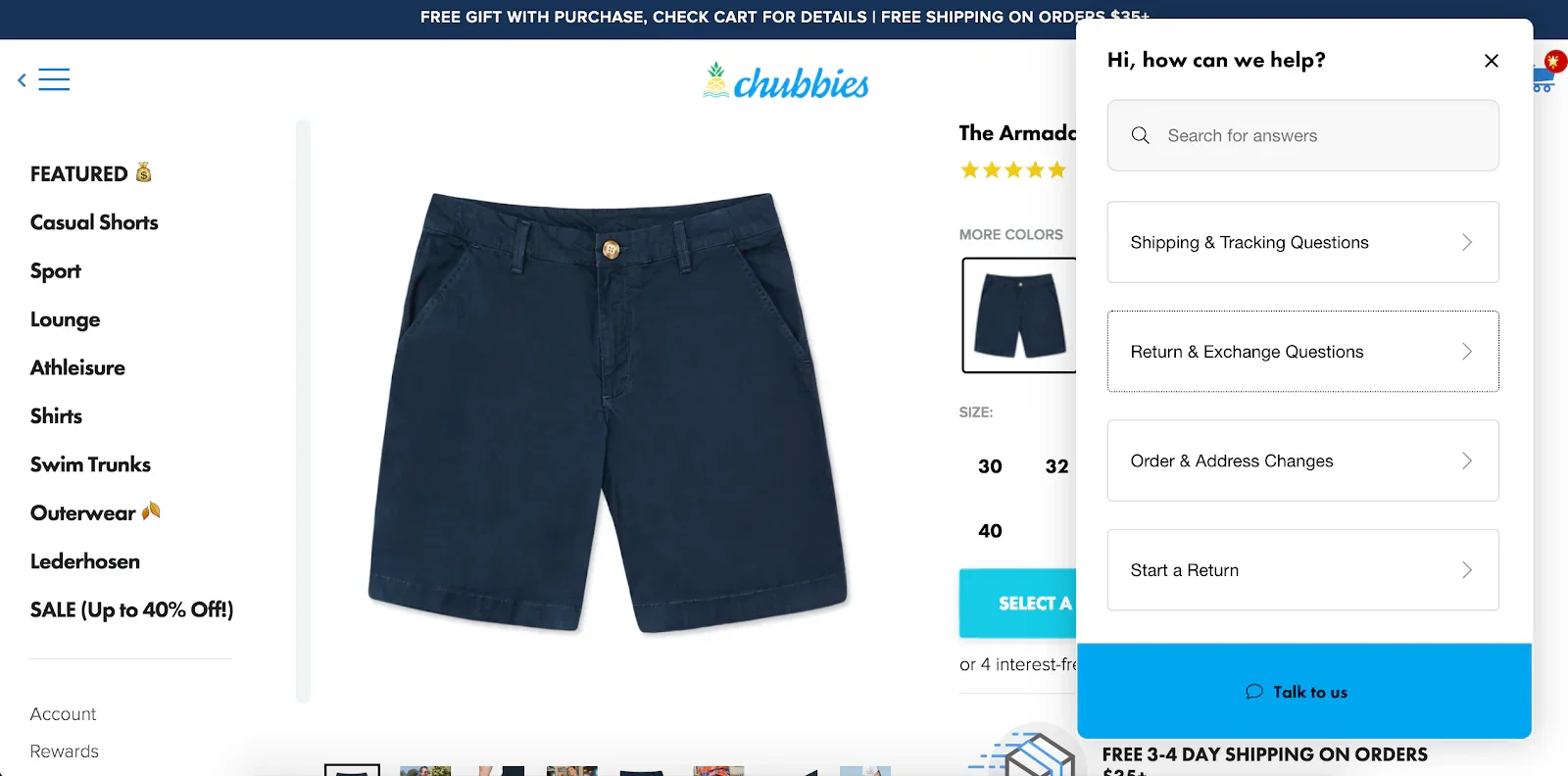How to Set up a Clear and Open Shopify Return Policy

One of the factors that customers care about when choosing your store is a clear and open return policy. They need the comfort of knowing they can return products they are not satisfied with. A friendly policy will improve their satisfaction, retain them, and encourage them to prioritize your store, thereby increasing sales.
Let’s explore the key factors to set up a clear and open Shopify return policy!
Returns vs refunds: What’s the difference?
Returns and refunds are customer actions in response to dissatisfaction during the purchasing process, but they differ in purpose and form.
A refund involves the customer requesting their money back, often because the product is damaged, lost, or they don’t want to wait for a replacement.
In contrast, a return occurs when a customer wishes to exchange a product, typically due to selecting the wrong size, color, or style or receiving the incorrect item due to system errors.
Importance of a good return policy
Since approximately 20% of online purchases are returned, having a well-crafted return policy is essential.
A good exchange system reflects a company’s integrity, as customers judge businesses based on how well their return policies work. A fair and clear exchange system helps build a positive image and attract more buyers.

Additionally, a strong return policy improves communication between businesses and customers, especially when there are issues with a purchase. It gives customers the chance to make another choice, protecting their rights while saving time and effort for both parties.
Steps to create a Shopify return policy
Step 1: Access Return Rules: Go to your Shopify admin, then click Settings > Policies. In the Return Rules section, click Manage.

Step 2: Set Return Window: Determine how long customers have to request a return after receiving their order.
Step 3: Handle Return Shipping: Choose how you’ll handle return shipping costs. You can charge a flat rate or other options.

Step 4: Add a Restocking Fee (Optional): If desired, add a restocking fee as a percentage.
Step 5: Exclude Final Sale Items (Optional): Select specific collections or products that cannot be returned. Click Add Final Sale Item or Add Final Sale Collection to add these items. Choose the items you want to exclude, then click Add and Save.

Step 6: Activate Return Policy: Click Turn on to enable your return policy.
Tips to create the best return process
Before you start writing your return policy, make sure to consider key factors such as the return timeframe, the condition of returned items, the return procedure, shipping policies, and situations where returns are not allowed. Please follow our guidance to create a highly effective and smooth return policy.
Consider what customers need in a return policy
Customers need a clear and concise return policy that outlines the following:
- Eligibility: What products or services are eligible for returns? Are there any exclusions?
- Timeframe: How long after purchase can customers return items?
- Conditions: What conditions must be met for a return to be accepted (e.g., the item must be in original condition, with tags attached)?
- Process: Step-by-step instructions on how to initiate a return, including any required documentation or forms.
- Refunds: How will refunds be issued (e.g., store credit, original payment method)? What is the expected processing time?
- Shipping: Who is responsible for return shipping costs? Are there any exceptions?
- Exchanges: If exchanges are allowed, what is the process for exchanging items? Are there any fees or restrictions?
By offering clear and thorough information, you can instill confidence in customers regarding their purchases and ensure the return process is as smooth as possible. A well-thought-out return policy not only enhances customer satisfaction but also builds trust and loyalty in the long run.
Set the appropriate allowed return timeframe
Be clear about the time frame in which customers can return products. Typically, online stores allow returns within 14 to 30 days from the purchase date. You can choose a shorter or longer time depending on your products and balance with customer needs.
Specifying a clear time frame will help customers know how long they need to act.
Besides the time customers need to return items, you should also consider the time to process return requests, including inspecting returned products and refunding or exchanging items.
Define specific return conditions
You need to set specific conditions for the state of the product when returned. The product should be intact, in its original packaging, and unused. This helps you ensure that the product does not lose its value and can be resold.
Additionally, you should require customers to provide proof of purchase, such as a receipt or order number, to verify the transaction. This will also help you manage the return process more effectively and accurately.
Offer your customer clear guidelines on the return process
Provide detailed instructions on how customers can return items. Include necessary steps, from contacting customer service to sending the product back.
Specify the address where customers should send the returned product. If you have multiple warehouses, designate the most appropriate one for returns to reduce shipping and processing times.
You should also clarify who will bear the shipping costs, under which circumstances the store will cover the shipping fees (defective products, incorrect orders, etc.), and when the customer needs to pay these fees (color exchange, size exchange, different products, etc.).
Ensure a clear return policy
Make sure your refund policy is clear. Customers should understand how they will be refunded and the timeline for receiving their refund once the return request is approved.
If customers wish to exchange products, outline a specific process for exchanges, whether it’s for a different size, color, or a completely different item.
Clearly state non-returnable products
There are special cases where you cannot apply the return policy for customers. Clearly state which products cannot be returned, such as sale items, personalized products, or used items. This helps customers understand the limitations and avoid invalid return requests.
If there are any special conditions (e.g., defective or damaged products), specify how to handle them in the return policy. This helps build trust and customer satisfaction.
Make sure customers see the return policy before shopping
You need to ensure that customers can easily find it before making a purchase. If a frustrated customer approaches you about returning a final sale item, simply directing them to the return policy is unlikely to resolve the issue.
To avoid repeated conversations with customers who miss the policy, include links to your return policy in several prominent locations on your website. Here are some key places to display it:
- Website footer
- Website banner
- FAQ page
- Product page
- Order confirmation emails
- Website chat

Source: Shopify
Ensure consistency and accessibility for your shopify return policy
You need to ensure that the return policy information is consistent and unambiguous across all your communication channels. Make sure that the terms and conditions of the Return Policy are presented clearly and in detail.
Also, place links to the Return Policy in visible and easily accessible locations on your website, such as in the footer, on the homepage, and on product detail pages. This helps customers quickly find the Return Policy when needed.
You can also create an FAQ section about the Return Policy to answer common questions that customers may have. This not only helps reduce support requests but also increases transparency and trust from customers.
The Return Policy should be reviewed and updated periodically to accurately reflect any changes in your business operations and new customer requirements. Listen to customer feedback about the Return Policy to improve and optimize it further in the future.
Create Automated Shopify Returns
To create an automated return process on Shopify, you can apply some steps and solutions to manage and process return requests efficiently:
- Use Return Management Apps: Implement Return Management Apps and free tools to help manage Shopify returns.
- Integrate Automated Emails: Set up automated emails to confirm when a return request is successfully submitted, notify customers when their return request is processed, and send reminder emails to update the return status.
- Provide an Online Return System: Create a simple and user-friendly online return registration page, ensuring customers can easily fill in product information, return reasons, and their requests.
- Track and Analyze Returns: Use analytics tools to monitor the number of return requests, processing times, and common reasons. Use this data to improve processes and optimize customer experience.
By applying these solutions, you can create an efficient automated return process on Shopify, enhancing customer experience and reducing the management effort in handling return requests.
The automation process also allows your business to focus on core activities and improve overall business efficiency.
How to write a return policy
The first step in establishing a return system is to formalize your policy, allowing you to communicate it clearly to your customers. A written return policy ensures that all requests are handled consistently, avoiding the inefficiencies and added costs of addressing issues on a case-by-case basis.
While return policies may differ based on your e-commerce business’s logistics and the products you sell, every policy should include the following key elements:
- Returnable Items: Specify which items can be returned.
- Exchangeable Items: Clarify which items are eligible for exchange.
- Final Sale Products: Identify products that are non-returnable and non-exchangeable.
- Return Timeframe: Indicate when items can be returned or exchanged (e.g., within 30 days of purchase with the receipt).
- Condition for Returns: Describe the acceptable condition for returned items (e.g., lightly worn, with tags, in original packaging).
- Refund Options: State what customers can expect in terms of refunds (e.g., store credit, full refund, exchange for a product of equal value).
- Initiating Returns or Exchanges: Provide clear instructions on how to start a return or exchange (e.g., an email address to contact or a specific webpage to visit).
Note: If your store utilizes other sales channels, be aware that these marketplaces have their own return policies, which may differ from what you outline in your retail return policy.
Conclusion
A clear and transparent return policy not only helps you build trust with customers but also minimizes business hassles.
By considering appropriate factors, understanding customer needs, ensuring consistency and accessibility, and automating the return process, you can set up an effective return policy on Shopify.
This will help you improve the shopping experience, enhance trust, and retain customers for the long term.







